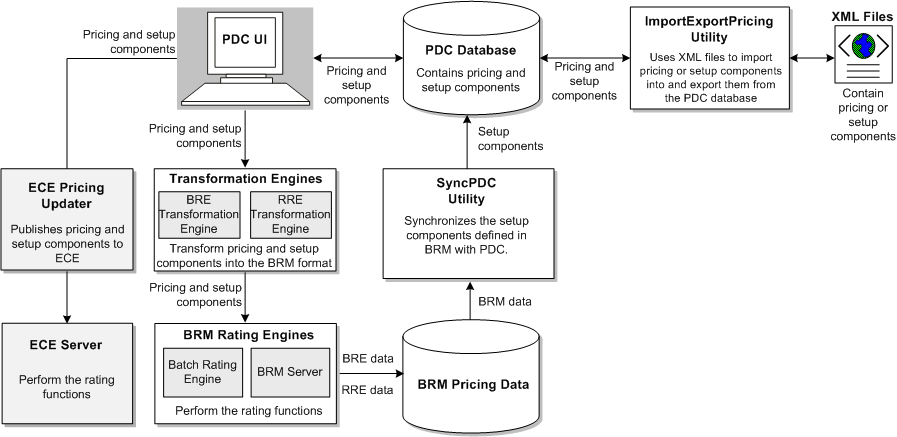1 About Pricing Design Center
This chapter provides an overview of Oracle Communications Pricing Design Center (PDC).
Overview of PDC
PDC is a Web-based application that you use to create and manage your product offerings. A product offering represents the services you offer to your customers and the price of those services. A service is a commodity, such as a mobile phone line or an Internet connection, that your customers can purchase and use.
Product offerings comprise of pricing components that contain the criteria your billing system uses to calculate the price of your services and to determine how the services are offered to your customers. Pricing components include the following:
-
Charge Offers: Specify how to charge your customers for your services. A charge offer consists of one or more charges that specify the cost of each billable event that affects a customer's account.
-
Discount Offers: Specify when and how to reduce the cost of a billable event or to change the balance of an element such as free minutes or loyalty points. Discount offers consist of one or more discounts.
-
Chargeshare Offers: Specify which events qualify for charge sharing and the conditions that must be met for charge sharing to apply. Additionally, they contain the pricing to determine the charge sharing amounts and balance impacts.
-
Bundles: Contain one or more charge offers, discount offers, or both. You create offers as the building blocks of bundles and can reuse them in multiple bundles.
-
Packages: Contain one or more bundles. You use packages to offer one or more services to customers. For example, you can offer one service with two different ways of charging for it, each defined in a separate bundle. When you create a package, you choose which of the bundles to include in the package.
-
Package List: Contain a group of packages that is usually offered to a single type of customer. To make packages available for customers to purchase, you must include them in a package list.
-
Selectors: Contain one or more rules based on the values of attributes in an event. Selectors are used in charge offers and discount offers to select between multiple charges, discounts, impact categories, or pricing instances.
-
Time Models: Contain a set of time periods that consists of time segments that represent a particular time. Time models are used in charge offers to charge different prices for the same service depending on the day and time the service is used.
See "About Creating Product Offerings" for more information.
You also use PDC to configure setup components, which are the prerequisite data used to create pricing components. Setup components include the following:
-
Extended pricing features, such as time models, that enables you to apply different prices based on the time the event occurred
-
Ratable usage metrics (RUMs), which contain a set of information used by the rating engine to measure an event
-
A service-event map, which links each service your system supports to the events that can have charges configured for that service
-
Zone models, which are used to charge for calls based on their origin and destination
See "About Configuring Setup Components" for more information.
To help you efficiently manage product offerings, PDC provides changeset management for grouping and publishing setup and pricing components. See "About Changesets" for more information.
PDC is based on open application standards and is compliant with the TeleManagement Forum Shared Information/Data (TMF SID) model.
About the PDC Application Architecture
The PDC application architecture consists of the following components:
-
PDC UI. The PDC UI is a Web-based user interface that you use to create and manage your product offerings.
-
PDC database. The PDC database stores the pricing components and setup components that you configure in PDC, as well as the pricing data defined in Oracle Communications Billing and Revenue Management (BRM) and rating systems that are synchronized with PDC.
-
BRM Integration Pack. The BRM Integration Pack provides the interface between PDC and BRM.
-
ImportExportPricing utility. The ImportExportPricing utility provides an XML-based command-line interface for importing pricing and setup components to and exporting pricing and setup components from PDC.
Figure 1-1 shows the PDC application architecture and the process flow when used with BRM and ECE:
Figure 1-1 PDC, BRM, and ECE Integration Architecture

Description of ''Figure 1-1 PDC, BRM, and ECE Integration Architecture''
About the PDC and BRM Integration Process Flow
The BRM Integration Pack provides the interface between PDC and BRM to transform and load the pricing data configured in PDC into BRM and to synchronize the pricing data defined in BRM and the rating system with PDC.
Note:
PDC supports BRM 7.5.The BRM Integration Pack contains:
-
Transformation engines: When you use real-time and batch rating engines for usage charging, the transformation engines convert pricing components and setup components configured in PDC into the format required by BRM and then loads the components into the BRM database.
-
SyncPDC utility: The SyncPDC utility provides the capability to synchronize setup components defined in BRM with PDC. It also synchronizes event data defined in the rating system with PDC. See "Synchronizing Setup Components" for more information.
BRM uses the pricing and other data to measure customer activity and determine how much to charge the customer for the use of the services. See BRM documentation for information on how the rating is performed.
About the PDC and ECE Integration Process Flow
When you use ECE for usage charging, the ECE Pricing Updater automatically converts pricing components and setup components configured in PDC into the format required by ECE and then loads the components into ECE. The ECE Pricing Updater is packaged with ECE. See ECE documentation for more information.
ECE uses the pricing data and the pricing-related configuration data defined in PDC to rate the usage requests it receives. See ECE documentation for information on how ECE rates the usage requests.